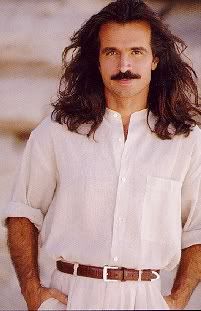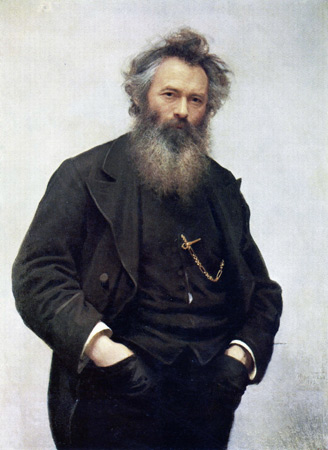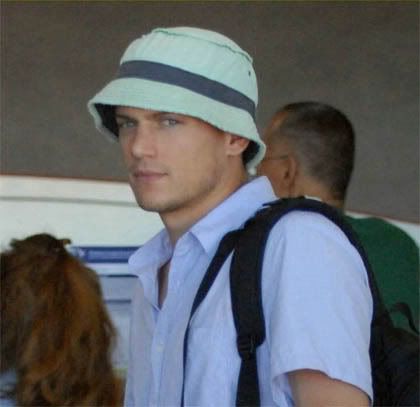 Two Kinds Of Art Wentworth Miller & Zaha Hadid They have nothing in common. At a first glance. They come from different worlds, have different backgrounds, have different professions but still they meet somewhere. Their impact on people is so impressive that one could say that they have the same kind of driving force behind the apparent surface. One of them was born in UK on June the 2nd , 1972 in a small quiet town near Oxford, Chipping Norton. The other was born in Iraq on October the 31st, 1950 in a big busy city, Baghdad. And it seems that the first images of the world that they perceived have left visible traces in both their personalities. Both start off their careers on paths that turned out to be different from the ones they eventually followed. Zaha first got a degree in mathematics in Beirut; Wentworth studied English literature in Princeton. At a certain point after graduation both realize that they were meant for something else. And that was a fortunate moment because time still proves it that the second choice was the right one in both cases. Having made up their minds about the next step, they decide to leave their home land and move towards their new lives. He's dreaming of being an actor, she's dreaming of being an architect.  In the midsummer of 1995 he packs up his stuff, loads everything in the trunk of his car and starts “The Big Journey” from New York to LA that was meant to be one of the toughest he had ever made: hot weather, endless trip, old car, no A/C through the dessert. Just a water spritzer to bring a bit of coolness on his face from time to time, and the strong belief that he's doing the right thing. LA was no bed of roses in the beginning. A lot of boring work behind the camera, way behind it as a matter of fact, not enough revenue, acting classes in the evening, many questions about the decision he had made but also a lot of hope for the future. He had finally made the big step he always wanted to make, he had overpassed everybody's and his own's doubts about changing so dramatically the direction in his life and started to chase his dreams. Will his boldness and determination be rewarded? It remained to be prooved in the years to come. In the midsummer of 1995 he packs up his stuff, loads everything in the trunk of his car and starts “The Big Journey” from New York to LA that was meant to be one of the toughest he had ever made: hot weather, endless trip, old car, no A/C through the dessert. Just a water spritzer to bring a bit of coolness on his face from time to time, and the strong belief that he's doing the right thing. LA was no bed of roses in the beginning. A lot of boring work behind the camera, way behind it as a matter of fact, not enough revenue, acting classes in the evening, many questions about the decision he had made but also a lot of hope for the future. He had finally made the big step he always wanted to make, he had overpassed everybody's and his own's doubts about changing so dramatically the direction in his life and started to chase his dreams. Will his boldness and determination be rewarded? It remained to be prooved in the years to come.22 years ago, in the midsummer of 1972 (about the time he was preparing to be born) she had also said good bye to her friends and family and moved to London to study architecture, and this is where she still lives to this day. It looks that she was meant to become an architect. She was raised in one of Baghdad's first Bauhaus-inspired houses. In the late 1950's she witnessed and was impressed by the construction of Gio Ponti's planning ministry, a replica of his Pirelli Tower in Milan, a symbol of postwar Italian style. And she was always moved by the shapes and volumes and the way they could interact to give unexpected results. In the beginning of their careers both needed support. That support came in either case only from their strong personalities, as the others around them were still circumspect. ”In my own career as an actor, there were times when I was the only one who believed in myself in the face of the odds. I was the only one who was giving myself any kind of support.”, says Went when talking about this period. Both had to fight for recognition, but the path they had chosen to follow was not a hike in the park on a shiny day for neither of them. It required sacrifices. He had to overpass the opinion that acting is not a real job and reinvent himself in order to have the strength to chase his dream and become an actor; she, on the other side, had an extremely bold and visionary opinion on what a building was supposed to be and how this expressed itself through shape and materials, opinion that was years ahead from that time's mainstream. Her first projects have left all on paper, all unbuilt, but nevertheless they transformed the expectations of what architecture could be.Those projects along with her paintings (Zaha is an artist as well as an architect) make now the object of expositions held all over the world. After three years of working in the unseen field of the movie business , Went had acquired precious experience in the secrets of producing and promoting a film, that will provide him with a “pulse of a bureaucrat” that came to sustain “a soul of an artist”, as he himself describes it. It was then the right time to start his real career, and his first role came in 1998 in “Buffy the vampire slayer”, then another the next year in “Time of your life”, then again in “Popular”in 2000, but he was still back and forth between his “behind the camera” job and the auditions for new roles. A few months later he appears in ER, then in “Romeo and Juliet” and “Room 302”, but his first major role comes in 2002 in the mini series “Dinotopia” where he plays David, one of the brothers in the story. This time the part he played was a complete acting experience that will give him the full taste of an acting job. The next year is the year of his outbreak. He manages to secure two roles, the doctor's character in “Underworld” and the powerful role of Coleman Silk in “Human Stain”. This movie, besides its importance for his career, is a revelation to him as an individual. He realizes now that all that range of intense emotions that he had lived while playing this role, a role that was so near to his own real experience, are now exposed to the outside world and cease to be hidden in his soul and controlled by him. The movie deals a lot with the bidirectional racism and this was something he himself had experienced many times, so many that you can feel the sorrow in his words when he talks about this: ”Someone calls you "nigger" and it's like a knife to the gut. To be in that sort of situation it's just a little nick, but you suffer enough nicks and you bleed to death just the same.” Despite its brilliant plot and the great acting of the cast, the film wasn't the success that everybody expected, but the good thing is that it brings Went into the limelight and shows his talent in a difficult role. There will pass two more years of smaller roles till the real outbreak of the actor Went. He plays in “The Confession”, ”Joan of Arcadia”, ”Ghost Whisperer” and does the voice in “Stealth”. More experience for Went, less time left till the overall recognition. And the recognition finally came in 2005. It came as a flood and left no doubt at all about his charismatic acting gifts. After long auditions for the leading role of Michael Scofield, the producers had almost lost hope that they will find the right person for this role. He was the last auditioned. And the decision was taken so fast that he hadn't even the time to realize what was happening to him. He was Michael Scofield, he was voluntarily going to prison to save his brother Loncoln Burrows. And the rest of it is already history. Prison Break is a hit and Went is continuously stopped in the street by people who want to congratulate him for his courage in fighting to save his “brother” and in trying to bring down the Company. What more does an actor need than to be identified with the character he plays? But it seems that Went never took too serious the whole success thing and still, after all these years, he can be so detached and joke about all that ...with a characteristic subtle English humor that was perhaps one of the things that were left in his personality by the short passing he made through the streets of Chipping Norton. London was in the depths of recession when Hadid arrived as a student in the 1970s. Its architects were experiencing both a shortage of work and a loss of confidence. Modernism, as pioneered by Le Corbusier and Mies van der Rohe in the 1930s, looked dead and the utopias of the 1960s worn out. The university where Zaha studied provided a unique centre for debate about new directions in design. Bernard Tschumi, Rem Koolhaas, Leon Krier and Brian Anson were all on the teaching staff at that time, which was an unhoped for opportunity to be in touch with the most brilliant minds of contemporary architecture. The experience clearly had a profound effect on her. The school provided an environment in which she could explore one of the twentieth century’s great art movements, Russian Constructivism (I looooove it!!!!). This revolutionary period was the point of departure for her architectural concept that is a unique expression of the most powerful architectural current of the twilight of the 20Th Century - the Deconstructivism (....looooooove that one too!!!!). She belonged to a generation familiar with the idea of architecture as a theoretical activity in which design drawings were as important as building. The delay between conceiving the designs that made her reputation, and building them for reasons of lack of technological means, made it inevitable that Zaha would be represented as being more concerned with theory than practice. Only now, 25 years after her first visionary projects, the means have evolved enough to make possible that more and more of her flamboyant works become reality. Her radical theory on architecture and her full dedication to it is mirrored in her own words: ”Architecture requires 100% dedication. If it doesn't kill you, then you're no good. I mean, really - you have to go at it full time. You can't afford to dip in and out. I can be my own worst enemy. As a woman, I'm expected to want everything to be nice, and to be nice myself. A very English thing. I don't design nice buildings I like architecture to have some raw, vital, earthy quality.” Besides the wide collection of her paintings, I should mention some of the buildings that have been raised from her projects are: Zaragoza Bridge Pavillion, Nordpak Cable Railway in Innsbruck, Guangzhou Opera House in China, Cagliary Contemporary Arts Centre in Cagliary Italy, Rosenthal Center for Contemporary Art in Cincinnati Ohio, BMW Central Building in Leipzig, Phaeno Science Center in Wolfsburg, Ordrupgaard Museum Extension in Copenhagen, Centre of Contemporary Arts in Rome, Ferry Terminal in Salerno, Terminus Hoenheim in Strasboug, Bergisel Ski Jump in Austria and more others. In both Wentworth's ans Zaha's cases the appropriate thing to say about their careers is that the best is still to come. Both have tremendous hidden qualities and creative resources, and both are now international symbols that make the world have great expectations and hopes as regards to their next steps. These are two of my favorite people. Both impressed me in a great measure, one of them touches my mind, the other touches my soul. I hope i was able to pass a piece of my admiration in my story and I hope you enjoyed reading it as much as i enjoyed writing it. If you want to learn more about Zaha's work, this is a good link: http://www.arcspace.com/architects/hadid/hadid_features.html About Went I assume you know all the links and you may know a great deal more than me. Thanks to wentworth-underground.com for the Went pics, to excomm (http://www.wentinfo.com/forum/) and Ladiu for infos on Went's career, and to London Design Museum and others for infos on Zaha's work. For those who were kind enough to read my story till the end, here's another slideshow dedicated entirely to Wentworth. |
November 15, 2008
Julia's artists of the week: Wentworth Miller & Zaha Hadid
November 10, 2008
Bebo's artist of the week.
November 01, 2008
Detected's artist of the week: Ivan Ivanovich Shishkin (1832-1898)

Subscribe to:
Posts (Atom)










